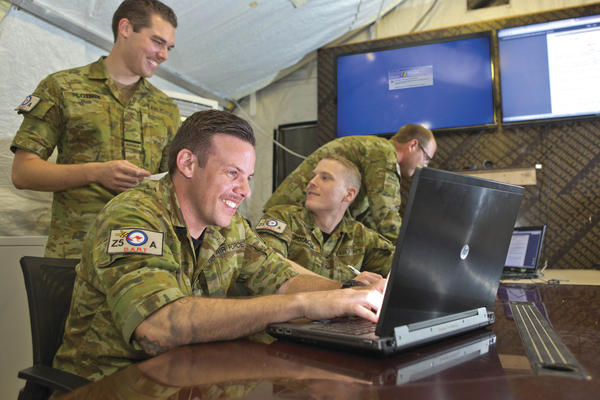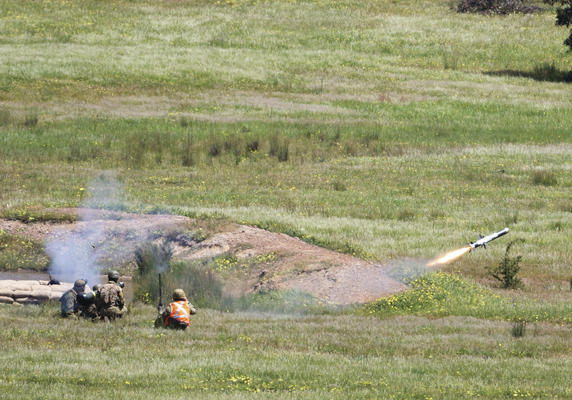What does Integrated Air Missile Defence (IAMD) look like for the RAAF, indeed, what's the next step of Integrated Missile Defence (IMD) for the wider ADF?
Katherine Ziesing | Canberra & Huntsville
There are roughly 40 programs that will provide the broad church that is ADF-wide IMD. The best known of these programs come under two banners: Air 6500 from the Air Force and Land 19 Phase 7B from Army. The first is about IAMD in the medium to long-range environments, while Air 6500 has a focus more on the medium to long-range threats.
There is a fifth generation focus in the Air 6500 realm; making the most of the mountain of sensors that a range of platforms and capabilities will provide. Warfighting will be less about the fog of war and more about navigating a sea of data.
As ADM has previously mentioned, a restricted briefing to four US primes (Boeing, Lockheed Martin, Raytheon and Northrop Grumman) took place last year. This was the first official time Defence and industry sat in the same room to compare notes on what IMD and IAMD looked like.
Industry sources from all four companies have been impressed with the program office approach to get an idea of what technology is out there now; also its understanding of how doctrine combined with such technology can evolve to meet the threats posed by a world characterised by transient advantage or the third offset.
To get an idea of the thinking from the industry side of the house, ADM approached all four primes to explain their thinking behind the concepts that underpin Air 6500. There are common themes throughout the responses, but one element is clear: there is no single off the shelf system to achieve the outcomes the ADF is looking for.
Lockheed Martin Australia
Air 6500 will enable the RAAF, and by extension, the ADF, to take full advantage of 5th Generation platforms to create a superior operational environment in face of unpredictable asymmetric threats, according to Lockheed Martin Australia’s head of Mission Systems Neale Prescott.
“It will create a fully networked ‘system of systems’ that synchronises air and missile defence operations in joint and coalition environments, improving situational awareness and enhancing the speed of decision making in the joint engagement zone,” he said.
Lockheed Martin has a track record integrating air, land, sea, space cyber domains for governments around the world, from developing the enterprise system that directs air operations for the US military forces, to enabling the Ballistic Missile Defence system to operate as a global network.
“We are continually advancing ways to reduce the ‘data to decision cycle’”.
Prescott said the company would bring this experience to Australia and, by leveraging an extensive knowledge of open architectures and cross domain solutions, it will enable the ADF to shift away from proprietary, closed, contractor-owned systems to develop a modular, government-owned enterprise that easily interoperates with legacy solutions and supports Joint, Allied and Coalition interoperability.
“We know there is no ‘off the shelf’ solution for delivering what the Australian Defence Force requires for Air 6500,” Prescott said. “Developing solutions to achieve the Air 6500 vision will take collaboration and a team that is committed to research and development to design systems that are unique. For Air 6500, we will partner with RAAF to lead the critical design work, including with other defence primes, to develop solutions that meet Australia’s specific defence requirements.”
Prescott also referred to the company's extensive research and development backbone which allowed it to draw upon its global network to bring leading edge technologies and innovations to Australia.
A key initiative in the Lockheed Martin approach is the establishment the Science Technology, Engineering Leadership and Research Laboratory (STELaRLab), a world-class multi-disciplinary facility to be established outside of the US for Lockheed Martin.
Their approach includes:
- Convergence of operations and intelligence environments
- Vertical integration of strategic, operational & tactical domains
- Horizontal integration across Air, Land, Sea, Space, and Cyber
As the prime developer and system integrator of the two 5th Gen assets, the F-22 and the F-35, Lockheed Martin, according to a statement from the company, is capable of developing the innovative systems that achieves the Plan Jericho vision of a seamless, network centric joint battlespace environment.
“We are continually advancing ways to reduce the ‘data to decision cycle’ by developing sophisticated artificial intelligence products that automate the intelligence cycle and enhance real time situational awareness,” Prescott said.
Raytheon Australia
“Raytheon has proven experience delivering advanced C4I solutions both in the US and internationally,” Raytheon Australia managing director Michael Ward explained to ADM.
“Furthermore, we design and build many of the advanced sensors and the core integrating technologies which characterise the next generation battlespace, and generate the situational awareness and decision-making superiority necessary to deliver future operational success.”
Despite asking for information in regard to Air 6500, information from Raytheon was keen to highlight their offerings in the Land 19 Phase 7B area, with a focus on Australian content via CEA Technologies radar technology. Details on their Air 6500 technology and thoughts were not forthcoming.
“Central to Raytheon Australia’s offering for Air 6500 will be MEDUSA, specifically responding to Army’s Land 19 Phase 7B program,” Ward said. “It is our solution based on the proven National Advanced Surface to Air Missile System (NASAMS) system that is fielded in seven nations, including the US.
“Demonstrating our commitment to building and strengthening Australia’s sovereign defence industry, Raytheon Australia believes that we can achieve 50 per cent local content for MEDUSA. This includes the option to include a truck mounted CEA Technologies radar and in other areas of the program, including:
- Launcher Assembly
- Launcher Structure & Sub-Systems
- Racking & Cable Systems
- AESA Radar
- Vehicles
- Vehicle Integration
- Sensor Housing
- Missile Loader System
Ward said that MEDUSA is capable of performing multiple missions, including indirect fire protection and C-RAM sense and warn, and provides interoperability with the current and future Australian Integrated Air Defence System, and with coalition forces.
Boeing Defence Australia
“Resonating with Defence's enquiries regarding evolutionary acquisition, one approach proposed by Boeing was to accelerate the current evolution of the in-service Air Defence Ground Environment (Vigilare),” Bill Madley, general manager of BDA's Command, Control, Communications & Information (C3I) Solutions division explained to ADM. “This approach would allow project funding, schedule and technical effort to be focussed on enhancing and acquiring necessary new elements and minimise the Commonwealth’s exposure to associated major program acquisition challenges.”
 Cyber security of any IAMD system is crucial. Credit: Defence
Cyber security of any IAMD system is crucial. Credit: Defence
Madley noted that Vigilare already incorporates a comprehensive national surveillance capability that meets the core information processing needs for Air 6500. Since accepting Vigilare earlier this decade, RAAF’s 41 Wing and Surveillance & Control System Program Office have adopted a highly collaborative relationship with industry. This relationship, which has evolution as a core principle, ensures Vigilare remains operationally effective in the changing battlespace and offers a proven framework for it to evolve as part of the future IAMD system of systems.
“Due to the nature of the IAMD capability sought by Defence, industry will need to work together and leverage both local capability and international expertise,” Madley said.
Northrop Grumman
There is much more an open architetcture/C2 focus coming from the team, led by Kenn Todorov as Director, Global Air and Missile Defense at Northrop Grumman. As former deputy of the US Missile Defence Agency, Todorov brings a unique perspective to the table. It was under his leadership that the agency proclaimed that all new C2 systems coming online from 2012 onwards have an integration capacity with the wider system of sensors and related technologies.
Speaking in mid-January from Huntsville, Alabama, he was keen to highlight the benefits of a modular approach with open architecture that is able to provide a development pathway in a transient advantage world.
A focus on relational awareness, above and beyond situational awareness, was key. Relational awareness encompasses not just situational awareness but also how elements within a battlespace affect one another on a timeline. In essence, what do I need to know when?
In terms of counter rocket and mortar (C-RAM) capabilities, Northrop Grumman already has form with the ADF under Land 19 Phase 7A. The various C4I programs sitting between the radars and WAVES (a loud siren system urging you to kiss the dirt right now!) included AMDWS (air and missile defence workstation) and FAAD C2 (Forward Area Air Defence Command and Control), were acquired via the FMS route.
The company plans on leveraging the work they’ve done in the US under the Army’s Integrated Air and Missile Defense Battle Command System (IBCS). A US$577 million, five-year, cost-plus-incentive-fee/cost-plus-fixed-fee contract was originally awarded in 2010. The contract was contested against an offering from Raytheon.
 Air 6500 focuses on medium and long range threats while Land 19 Phase 7B will address short and medium range missile defence. Credit: Defence
Air 6500 focuses on medium and long range threats while Land 19 Phase 7B will address short and medium range missile defence. Credit: Defence
IBCS is intended to connect the current arsenal of stand-alone systems into a greater whole, one in which any shooter – including potential future weapons such as lasers – can get firing data from any sensor.
The company is now at the point where they can attest to the workings of the system with three successful test flights in the last 18 months and another scheduled in 2017 in order to hit milestone C, the final decision US point before manufacturing. The system replaces seven legacy systems in a cohesive manner.
The air and missile defence systems that will be integrated via IBCS include:
- Patriot anti-air missile system;
- Surface-Launched Advanced Medium Range Air-to-Air Missile (SLAMRAAM);
- Joint Land Attack Cruise Missile Defense Elevated Netted Sensor (JLENS);
- Sentinel radar, and (if the US Department of Defense approves);
- Terminal High-Altitude Area Defense (THAAD); and
- Medium Extended Air Defense System (MEADS).
It is worth noting that Raytheon developed four of the systems that IBCS will integrate – Patriot, JLENS, SLAMRAAM, and THAAD.
The focus on 5th generation information operations in that the ‘any sensor, best shooter’ approach is integral to Northrop Grumman’s thinking on Air 6500; modular means opportunity.
“We don’t want to buy a box today that closes a door tomorrow,” Rob Evans, Northrop Grumman’s Director, International IAMD, concluded.
Thoughts
At this stage thinking in this space is also being supported by The Sir Richard Williams Foundation who are developing both an internal and external report for RAAF on IAMD, based on a series of closed workshops and wider research efforts. This in turn will be supported by a seminar in April this year on the issue.
Issues such as ‘left of launch’ (a term only coined two years ago in a US context) are relatively new in ADF thinking. A left of launch strategy is based on a pre-emptive strike with new non-kinetic technologies, such as electromagnetic propagation, cyber as well as offensive force to defeat missile threats before they are launched. The concept also has a strategic signalling effect to the adversary.
The opportunities offered by the adoption of fifth generation thinking, supported by a range of technologies, can be realised by the ADF in the 2020s and beyond if the right building blocks are in the foundation.
Note: The writer travelled as a guest of Northrop Grumman to the US. She is also a board member of The Sir Richard Williams Foundation.
This article first appearted in the February 2017 edition of ADM.





